6.4.1.2. Characteristic Page
This page defines characteristic values to contact between two geometry entities. Almost contact entities supported in RecurDyn are using this page.

Figure 6.288 Contact property page [Standard Contact Force]
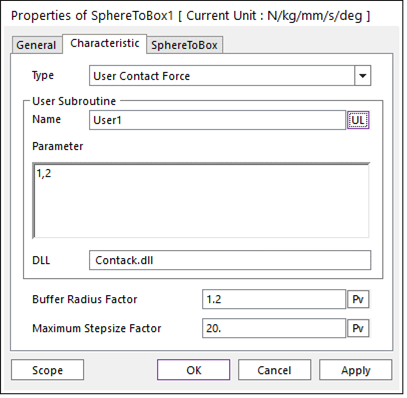
Figure 6.289 Contact property page [User Contact Force]
Type: Select a type as Standard Contact Force or User Contact Force.
Standard Contact Force: Defines the contact properties.
User Contact Force: Defines by user written contact subroutine. (Refer to Contact User Subroutine.
Buffer Radius Factor: The numerical integrator reduces the step size by the maximum step size factor if the action body come closer than Buffer radius factor* Action body radius.
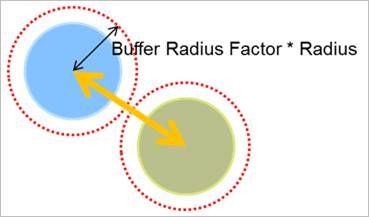
Figure 6.290 Definition of Buffer Radius Factor
Maximum Step size Factor: The maximum step size is reduced by a factor of maximum step size factor.
Standard Contact Force
The contact normal force is calculated by
\({{f}_{n}}=k{{\delta }^{m1}}+c\frac{{\dot{\delta }}}{\left| {\dot{\delta }} \right|}{{\left| {\dot{\delta }} \right|}^{m2}}{{\delta }^{m3}}\)
Where, \(k\) and \(c\) are the spring and damping coefficients which are determined by an experimental method, respectively. The \(m1\), \(m2\) and \(m3\) are the stiffness, damping and indentation exponents. \(\delta\) and \(\dot{\delta }\) are a penetration and time differentiation of the penetration, respectively.
Characteristic: Defines the contact properties such as the stiffness coefficient, damping coefficient, and friction coefficients. Also, these coefficients can be given as user-defined spline curves.
Stiffness Coefficient: Specifies a stiffness coefficient for the contact normal force.
Stiffness Spline: The spline shows the contact normal force for the penetration. For more information, click here.
Damping Coefficient: Specifies a viscous damping coefficient for the contact normal force.
Damping Spline: The spline shows the contact normal force for the velocity of penetration. For more information, click here.
Dynamic Friction Coefficient: Specifies a dynamic friction coefficient for the contact friction force. It has three options.
Dynamic Friction Coefficient: The constant friction coefficient is applied.
Friction Force Spline: The spline shows the fiction force for the relative velocity. It is recommended to use the spline that x and y values are defined as positive.
Friction Coefficient Spline: The spline shows the friction coefficient for the relative velocity.
Friction: Specifies some friction coefficients for the contact friction force.
Stiffness and Damping Exponent: Generates a non-linear contact normal force.
Indentation Exponent: Yields an indentation damping effect. When the penetration is very small, the contact force may be negative due to a negative damping force, which is not realistic. This situation can be overcome by using the indentation exponent greater than one.
User Contact Force
User Subroutine
Name: Shows the name of user specified subroutine.
Parameter: Shows the parameters used in the user specified subroutine.
DLL: Shows the name of which DLL contains the contact user subroutine.
6.4.1.2.1. Friction
Friction defines the friction of Contact. And the user can also define the type as the following table.
Friction Type |
Entities |
Sliding and Stiction Type |
Sphere To Sphere Contact |
Sphere In Sphere Contact |
|
Cam2D Contact |
|
CamLine2D Contact |
|
Circle In Circle Contact |
|
Circle To Circle Contact |
|
Sphere In Cylinder Contact |
|
Sphere To Cylinder Contact |
|
Sphere In Cone Contact |
|
Sphere To Cone Contact |
|
Sphere In Box Contact |
|
Sphere To Box Contact |
|
Sphere In Torus Contact |
|
Sphere To Torus Contact |
|
Cylinder In Cylinder Contact |
|
Cylinder To Cylinder Contact |
|
Cone In Cone Contact |
|
Cone To Cone Contact |
|
Sphere To Arc Revolution Contact |
|
Sphere To Arc Extrusion Contact |
|
Cone To Cylinder Contact |
|
Sliding Type |
Others |
Friction type can be selected. The default value is sliding type. The difference between them is shown in Figure 6.291, Figure 6.292 and Table 6.23.
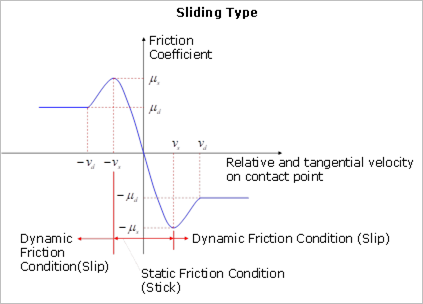
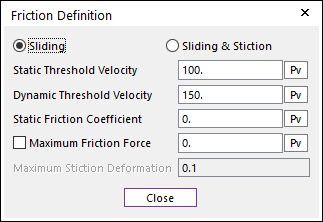
Figure 6.291 Sliding Type
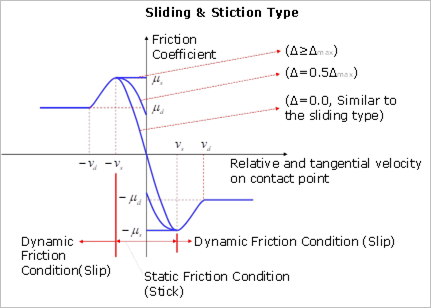
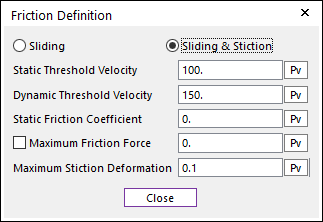
Figure 6.292 Sliding & Stiction Type
Static Threshold Velocity (\({{v}_{s}}\)): This value is a criterion between static and dynamic friction. If the relative velocity is less than this value, the friction is on static friction. If not, the friction is on dynamic friction. The friction coefficient of static friction region is calculated from following equation for the sliding type. The mathematical definitions of all friction types are defined in Table1.
\(\mu =\text{step5}(\nu ,\,\,-{{\nu }_{s}},\,\,{{\mu }_{s}},\,\,{{\nu }_{s}},\,\,-{{\mu }_{s}}\,)\)
Dynamic Threshold Velocity (\({{v}_{d}}\)): If the relative velocity between a contact pair is greater than this value, the friction coefficient is same as the specified dynamic friction coefficient. If the relative velocity between a contact pair is greater than Static Threshold Velocity and less than this value, the friction coefficient is defined as following. The detail mathematical definitions is defined in Table1.
\(\mu =\text{step5}\,(\nu ,\,\,{{\nu }_{s}},\,\,-{{\mu }_{s}},\,\,{{\nu }_{d}},\,\,-{{\mu }_{d}}\,)\)
Static Friction Coefficient (\({{\mu }_{s}}\)): Specifies a static friction coefficient.
Maximum Friction Force (\({{f}_{\max }}\)): If this is checked, the contact friction force is limited to this value.

Figure 6.293 Relationship between relative velocity and friction coefficient in the sliding friction type
The friction force of contact entities is determined by the following equations.
\({{f}_{f}}=-\,\text{sign}\,(v)\,\,\left| \mu (v) \right|\,\,\left| {{f}_{n}} \right|\)
\({{f}_{f}}=sign\,({{f}_{f}})\,\,\times \,\,\min \,(\,\left| {{f}_{f}} \right|,\,\,{{f}_{\max }}\,)\)
where, the \({{f}_{n}}\), \(\mu\) and \({{f}_{\max }}\) are the contact normal force, the friction coefficient and the maximum friction force, respectively. The friction coefficient of \(\mu (v)\) is determined by a relative and tangential velocity on the contact point.
Table 6.24 Comparison in inclined plane model Type
Sliding
Sliding & Stiction
Static friction condition (:math:`vle {{v}_{s}}`)
Mathematical definition for Static friction condition
\(\begin{aligned} & {{f}_{f}}={{\mu }_{v}}\left| {{f}_{n}} \right| \\ & {{\mu }_{v}}=\text{step5}(v,-{{v}_{s}},{{\mu }_{s}},{{v}_{s}},-{{\mu }_{s}}) \\ \end{aligned}\)
\(\begin{aligned} & {{f}_{f}}=\{(1-{{\beta }_{v}}){{\mu }_{\Delta }}+{{\mu }_{v\_step5}}\}\left| {{f}_{n}} \right| \\ & {{\beta }_{v}}=\text{step5}(\left| v \right|,-{{v}_{s}},-1.0,{{v}_{s}},1.0) \\ & {{\mu }_{\Delta }}=\text{step5}(\Delta ,-{{\Delta }_{\max }},{{\mu }_{s}},{{\Delta }_{\max }},-{{\mu }_{s}}) \\ & {{\mu }_{v\_step5}}=\text{step5}(v,-{{v}_{s}},{{\mu }_{s}},{{v}_{s}},-{{\mu }_{s}}) \\ \end{aligned}\)
Note1)
In steady state, the slip is constant. Because the friction force is function of relative and tangential velocity (\(v\))
In steady state, the slip is almost zero. Because, creep generate the stiction friction force for a stick effect.
Note2) Mathematical definition for Dynamic friction condition
\(\begin{aligned} & {{f}_{f}}=-\frac{v}{\left| v \right|}{{\mu }_{d}}\left| {{f}_{n}} \right| \\ & {{\mu }_{d}}=\text{step5}(\left| v \right|,{{v}_{s}},{{\mu }_{s}},{{v}_{d}},{{\mu }_{d}}) \\ \end{aligned}\)
Maximum Stiction Deformation: This controls the stick-slip effect on the contact. The value must be greater than or equal to zero. If the tangential velocity is smaller than the static threshold velocity, then the stick effect can be occurred. On the other hand, if the tangential velocity is greater than the static threshold velocity, then the friction model is on the slip condition.
Note
The friction coefficient of Sliding & Stiction Type is function of relative velocity and creep (\(\Delta\)) while the friction coefficient of Sliding Type is function of relative velocity.


